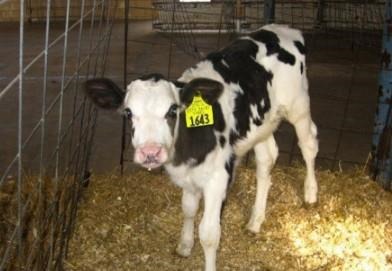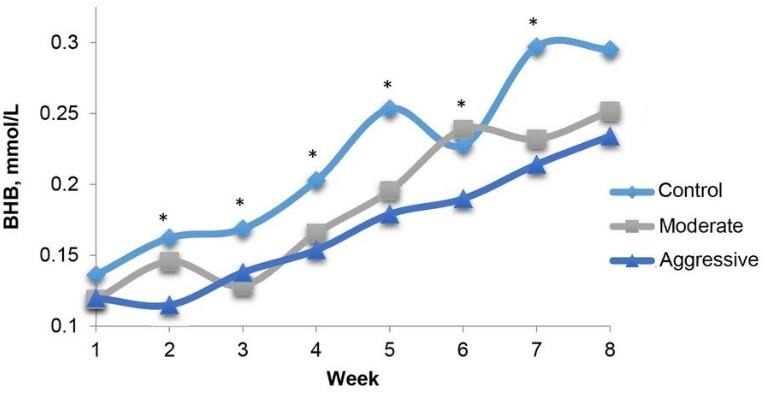By Colleen Chapman
Feeding more milk replacer to calves can increase average daily gain, but can reduce starter intake and lower nitrogen efficiency and postweaning digestion.

Within a dairy enterprise, one major cost is raising heifers due to high feeding expenses and extensive labor. Optimizing dairy heifer feeding programs is imperative for the sustainability and profitability of dairy operations. In order for cows to reach their full genetic potential, proper feeding and management of heifers are essential. Increasing the growth rate of young heifers may potentially decrease the age at calving, thereby decreasing heifer raising costs. However, increasing preweaning average daily gain (ADG) has to be balanced with adequate rumen development.
Conventional calf feeding programs have restricted the amount of milk and milk replacer (MR) fed during the preweaning period in an effort to encourage more solid feed intake, minimize the cost of feeding and labor, and reduce the potential for scours and other diseases (Kertz et al., 1979; Otterby and Linn, 1981; Davis and Drackley, 1998). Early and adequate intake of starter preweaning is important for the development of the rumen and to allow for early weaning. Due to the esophageal groove, milk and MR get shunted to the abomasum while starter and water go straight into the reticulorumen. Fermentation of starter in the rumen produces volatile fatty acids (VFA; propionic and butyric acids) that stimulate the growth of the rumen papillae to increase rumen surface area for more nutrient absorption. Greater starter intakes before weaning will ensure that intakes and weight gains will be sustained after weaning.
Other research has demonstrated that as more milk or MR is fed preweaning, preweaning ADG increases (Appleby et al., 2001; Jasper and Weary, 2002), but calves consume less starter, which can lead to a more stressful time during weaning and impaired rumen development (Huber et al., 1984; Cowles et al., 2006; Hill et al., 2010). This feeding strategy can compromise postweaning digestion and growth (Chapman et al., 2016). The amount of increased ADG is a function of the nutrients provided, and starter intake along with liquid feeding can both have some effects on first-lactation milk production. However, a recent meta-analysis showed that any increases in milk production in the first lactation accomplished by preweaning ADG were small and accounted for less than 3% of the variation (Gelsinger et al., 2016). These results show that most of the first-lactation milk production variation has to do with farm management, genetics, and health.
Calves fed more milk and MR that contain crude protein (CP) concentrations greater than 20 to 22%, as typically found in conventional MR, may be consuming an excessive amount of protein that will result in the excretion of nitrogen into the environment. Excessive feeding of CP to lactating cows and growing heifers increases fecal and urinary nitrogen, which can cause environmental problems (Wilkerson et al., 1997). Making sure there is not an excess of protein in the diet will also increase the profitability of dairy operations, because the cost of MR depends on the amount and source of protein as well as the feeding rate. High feeding rates of milk and MR may also have an effect on nitrogen utilization in the preweaned calf.
A study at the University of New Hampshire used 24 dairy heifer calves assigned to 1 of 3 treatments: 1) 1 lb of a conventional MR (control; 20% CP, 20% fat), 2) 1.5 lb of a moderately high protein MR (moderate; 26% CP, 18% fat), or 3) 2 lb of a moderately high protein MR (aggressive; 26% CP, 18% fat; Chapman et al., 2017). All calves had free-choice starter and water. At 5 weeks of age, urine was collected to determine urine nitrogen and chromium oxide was used as a marker to estimate fecal nitrogen. Results showed that calves fed the moderate and aggressive treatments had greater feed efficiencies and preweaning ADG compared with the control treatment, but reduced starter intake and lower nitrogen efficiency (Table 1). This could be due to moderate- and aggressive-fed calves having greater urine volume and therefore, greater urine nitrogen output compared with control calves.
| | Treatment1 | | P-value |
|---|
| Item | Control | Moderate | Aggressive | SEM | Trt |
|---|
a, b, c Means in the same row with different superscripts differ (P < 0.05).
1Control = 1 lb of a 20% CP, 20% fat MR; Moderate = 1.5 lb of a 26% CP, 18% fat MR; Aggressive = 2 lb of a 26% CP, 18% fat MR.
2N efficiency % = (N retention/N intake)*100. |
| N intake, lb/d | 0.11 | 0.12 | 0.12 | 0.0082 | 0.80 |
| Urine output, lb/d | 4.63c | 7.12b | 9.77a | 0.342 | <0.001 |
| N urine output, lb/d | 0.027b | 0.037a | 0.040a | 0.0028 | 0.02 |
| N in urine, % | 0.55 | 0.52 | 0.40 | 0.06 | 0.21 |
| Fecal DM output, lb/d | 0.73a | 0.54ab | 0.47b | 0.065 | 0.03 |
| N fecal output, lb/d | 0.029 | 0.024 | 0.024 | 0.0028 | 0.41 |
| N in feces, % | 3.93b | 4.73ab | 5.21a | 0.27 | 0.02 |
| N retention, lb | 0.060 | 0.050 | 0.054 | 0.0034 | 0.13 |
| N efficiency2, % | 52.7a | 46.7b | 44.4b | 1.19 | 0.01 |
In this study, calves fed aggressive and moderate treatments consumed only about 50% of the starter that the control-fed calves consumed during the preweaning period. This can be correlated with reduced rumen development, as was seen with control calves having significantly higher β-hydroxybutyrate (BHB) concentrations during the 56-day trial (Figure 1). Previous studies have suggested that circulating BHB levels may be an indicator of rumen development and starter intake in preweaned calves (Quigley et al. 1991; Deelen et al., 2016). Quigley et al. (1991) observed that total blood concentrations of VFA were greater in calves weaned early and that blood VFA concentrations responded rapidly to dry feed intake.

Figure 1. Weekly β-hydroxybutyrate (BHB) concentrations of calves fed 3 MR programs throughout the 56-d study. Control = 1 lb of a 20% CP, 20% fat MR; Moderate = 1.5 lb of a 26% CP, 18% fat MR; Aggressive = 2 lb of a 26% CP, 18% fat MR.
The decrease in starter intake during the preweaning period with high feeding rates of milk and MR can inhibit rumen development and digestibility of nutrients after weaning (Hill et al., 2010; Chapman et al., 2016). A similar study by Chapman et al. (2016), showed that calves fed greater than 1.5 lb of DM preweaning, had a reduction in postweaning organic matter digestibility of 11% and a reduction in neutral detergent fiber (NDF) digestibility of 28% comparted to control calves. These results indicate that postweaning digestion is lower than optimal and can contribute to lower postweaning growth. The large amount of MR and reduced dry feed intake preweaning can have detrimental effects after the calf is weaned. Feeding large amounts of milk and MR could continue to impair fiber digestion as the calf transitions to higher fiber diets as they age, though this has not been studied yet.
The cost of raising heifers is expensive. Therefore, optimizing the amount of protein and amount of milk and MR fed may improve heifer health status and feed utilization. Thus, through increasing the rate of gain and improving nutrient utilization, dairy operations can decrease their overall costs of feeding and managing heifers. Although efforts to reduce the costs of raising heifers is important for the profitability of dairy operations, it must be balanced with providing adequate nutrition, health, and management so that future production is not compromised.
Source:psu.edu